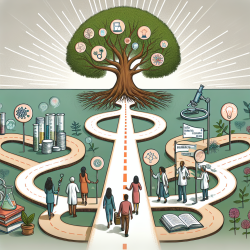Introduction
In recent years, the intersection of genetics and speech therapy has opened new avenues for understanding and treating speech disorders. A pivotal study titled A set of regulatory genes co-expressed in embryonic human brain is implicated in disrupted speech development offers groundbreaking insights into the genetic underpinnings of speech development, particularly in cases of Childhood Apraxia of Speech (CAS). This blog aims to distill the findings of this research for practitioners, highlighting how these insights can enhance therapeutic strategies and encourage further exploration in the field.
Understanding the Genetic Basis of CAS
The study leverages whole-genome sequencing to identify genetic mutations associated with CAS, a rare speech disorder characterized by difficulties in sequencing speech sounds. The research uncovers several de novo mutations in genes such as CHD3, SETD1A, and WDR5, which are implicated in neurodevelopmental pathways. These findings suggest that CAS, while rare, may have a strong genetic component, offering a new perspective on its etiology.
Implications for Speech Therapy
For practitioners, these genetic insights can be transformative. Understanding the genetic factors at play allows for more personalized therapy approaches. Here are some ways to integrate these findings into practice:
- Personalized Therapy Plans: Genetic testing can help identify specific mutations in patients, allowing therapists to tailor interventions that address the unique challenges posed by these genetic factors.
- Early Intervention: Recognizing genetic markers early can lead to earlier diagnosis and intervention, which is crucial in improving outcomes for children with CAS.
- Collaborative Care: Genetic insights can foster collaboration between speech therapists, geneticists, and neurologists, creating a multidisciplinary approach to treatment.
Encouraging Further Research
While the study provides significant insights, it also opens the door for further research. Practitioners are encouraged to engage with ongoing genetic studies and consider participating in research initiatives. By contributing to the body of knowledge, therapists can help refine and expand therapeutic techniques, ultimately enhancing the quality of care provided to children with speech disorders.
Conclusion
The integration of genetic research into speech therapy practices represents a promising frontier in the treatment of speech disorders. By embracing these insights, practitioners can offer more effective, personalized care, paving the way for improved outcomes in children with CAS. For those interested in delving deeper into the genetic aspects of speech development, the original research paper provides a comprehensive resource.
To read the original research paper, please follow this link: A set of regulatory genes co-expressed in embryonic human brain is implicated in disrupted speech development.










